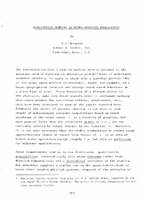| dc.description.abstract | The investigation that I wish to outline here originated in the military need of forecasting detection p r obabilities of underwater acoustic emitters, in case s in which only a somewhat general idea of the sound speed profile i s available, based, for example, on a known geographical location and average sound speed behaviour at a given time of year . Since detection of a distant object is the objective, only very fa i nt signals enter - certainly nothing that could produce the non-linear effects, shock-waves, etc . , that have been discussed in many of the papers reported here. Evidently the object of pre s ent interest is not this or that result of meticulously accurate computations based on exact knowledge of the sound speed c as a function of position, but more general facts that are relatively stable - i.e., are not radically altered by slight changes in the function c. Moreover, it is not only necessary that the stable evaluations be rather rough approximations (since we cannot know values of c in an area of future enemy operations except roughly ) - but this is sufficient for military applications. | |
